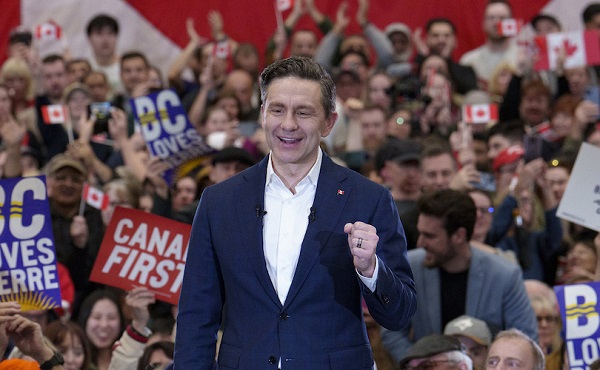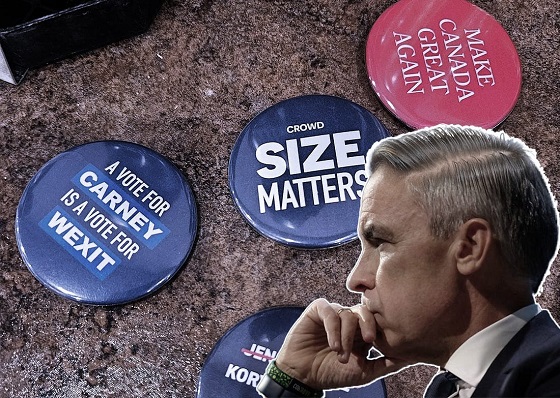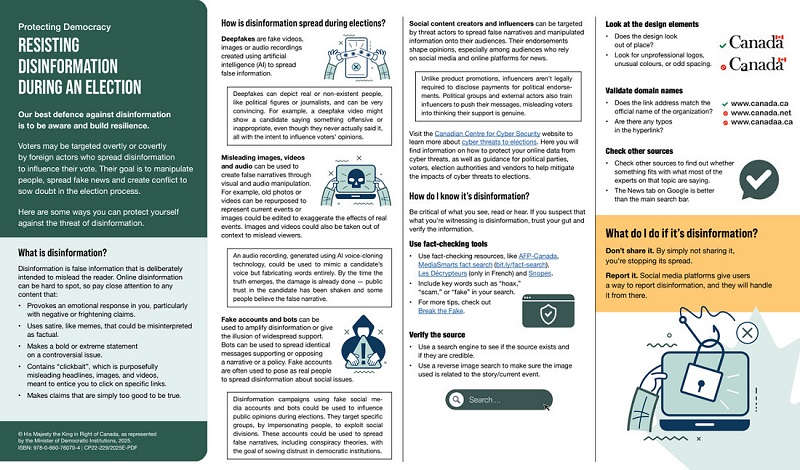Business
Why a domestic economy upgrade trumps diversification

From the Macdonald Laurier Institute
By Stephan Nagy for Inside Policy
The path to Canadian prosperity lies not in economic decoupling from the US but in strategic modernization within the North American context.
President Donald Trump’s ongoing tariff threats against Canadian exports has sent shockwaves through Ottawa’s political establishment. As businesses from Windsor to Vancouver brace for potential economic fallout, a fundamental question has emerged: Should Canada diversify away from its overwhelming economic dependence on the United States, or should it instead use this moment to modernize and upgrade its economic hard and software within the North American context? The evidence overwhelmingly supports the latter approach in which Canada reduces interprovincial trade barriers and regulations, builds infrastructure to move energy and other resources within Canada, and invests in Canadian human capital and relationships with the US to maximize synergies, stakeholder buy-in and mutual benefit.
The knee-jerk reaction to blame Trump’s economic nationalism misses a crucial point: America’s retreat from championing global free trade began well before his unorthodox political ascendance in 2016. The Obama administration’s signature Trans-Pacific Partnership (TPP) faced mounting bipartisan skepticism before Trump withdrew from it in 2017. Hillary Clinton, during her presidential campaign, explicitly stated she would oppose the deal, reversing her earlier support. “I will stop any trade deal that kills jobs or holds down wages, including the Trans-Pacific Partnership,” Clinton declared during a campaign speech in Michigan in August 2016.
When President Joe Biden took office, rather than resurrect the TPP, his administration proposed the Indo-Pacific Economic Framework (IPEF). Unlike traditional trade agreements, the IPEF conspicuously omitted market access provisions while emphasizing supply chain resilience and environmental standards. During the IPEF ministerial meeting in Los Angeles in September 2022, U.S. Trade Representative Katherine Tai specifically noted that the framework “moves beyond the traditional model” of free trade agreements.
These policy evolutions reflect a deeper transformation in American economic thinking: a bipartisan consensus has emerged around industrial policy aimed at rebuilding domestic manufacturing, securing critical supply chains, and maintaining technological leadership against authoritarian competitors such as China.
Prime Minister Justin Trudeau and his Cabinet fundamentally misunderstood these shifts, leading to a series of diplomatic missteps that have damaged Canada-US relations. Most damaging has been a pattern of public rhetoric dismissive of both Trump personally and his MAGA supporters more broadly.
In June 2018, following the G7 summit in Charlevoix, Quebec, Trudeau declared in a press conference that Canada “will not be pushed around” by the United States, characterizing Trump’s tariffs as “insulting.” This prompted Trump to withdraw his endorsement of the summit’s joint statement and label Trudeau as “very dishonest and weak” on Twitter.
Former Deputy Prime Minister Chrystia Freeland repeatedly aligned the MAGA movement with authoritarianism. In an August 2022 speech at the Brookings Institution, she characterized Trump supporters as part of a global “anti-democratic movement.” In October 2023, she went further, drawing parallels between MAGA and authoritarian regimes like Russia and China. These statements resonate poorly with nearly half of American voters who supported Trump in recent elections and are borderline disinformation with such exaggerated mischaracterizations of American voters.
Former Foreign Affairs Minister François-Philippe Champagne was caught on camera in December 2022 referring to Trump’s policies as “deranged” while speaking with European counterparts. The video, which social media users circulated widely, further inflamed tensions between the administrations.
Such diplomatic indiscretions might be dismissed as political theatre if they didn’t coincide with concrete policy failures. The Trudeau government neglected critical infrastructure projects that would have strengthened North American economic integration while reducing Canada’s vulnerability to U.S. policy shifts.
To illustrate, Japan and Germany approached Canada to secure liquefied natural gas (LNG) exports as part of their efforts to reduce reliance on Russian energy supplies. Japan expressed high expectations for Canadian LNG during Prime Minister Fumio Kishida’s visit, while Germany explored LNG opportunities during Chancellor Olaf Scholz’s visit, emphasizing the urgency of diversifying energy sources due to geopolitical tensions. However, Trudeau rejected these requests, citing a weak business case for LNG exports from Canada’s East Coast due to logistical challenges and lack of infrastructure. Instead, Trudeau shifted focus to clean energy initiatives and critical minerals, reflecting Canada’s evolving industrial policy priorities.
The economic relationship between Canada and the US represents perhaps the most thoroughly integrated bilateral commercial partnership in the world. The statistics alone tell a compelling story: daily two-way trade exceeds $3 billion, supporting approximately 2.7 million Canadian jobs – roughly one-in-six workers in the country.
This integration manifests in countless ways across industries.
For example, in automotive manufacturing, a single vehicle assembled in Ontario typically crosses the Canada-US border seven times during production. A Honda Civic assembled in Alliston, Ontario, contains components from both countries, with engines from Ohio and transmissions from Georgia integrated with Canadian-made bodies and electronics.
The energy infrastructure between the two nations functions essentially as a single system. The North American power grid delivers Canadian hydroelectricity to major US markets, while Canadian refineries process crude oil from both countries. TransCanada’s natural gas pipeline network serves both markets seamlessly, with approximately 3.2 trillion cubic feet flowing between the countries annually.
In aerospace, Bombardier’s commercial aircraft division collaborates with American suppliers like Pratt & Whitney and Collins Aerospace, creating integrated supply chains that span the border. Montreal’s aerospace cluster works in close coordination with counterparts in Seattle and Wichita.
Beyond traditional industries, American-Canadian technological collaboration has accelerated in recent years. For example, the Vector Institute in Toronto has established formal research partnerships with MIT’s Computer Science and Artificial Intelligence Laboratory, collaborating on foundational AI research. Their joint papers on neural network optimization have been cited more than 3,000 times since 2020.
Quantum computing initiatives at the University of Waterloo’s Institute for Quantum Computing maintain ongoing research exchanges with Google’s quantum computing team in Santa Barbara, California. Their shared work on quantum error correction protocols has advanced the field significantly.
In clean technology, Hydro-Québec’s energy storage division and Massachusetts-based Form Energy announced in 2023 a $240 million joint venture developing grid-scale iron-air batteries to enable renewable energy deployment across North America.
The SCALE.AI supercluster, headquartered in Montreal, includes American tech giants like Microsoft, Amazon, and IBM collaborating with Canadian start-ups on supply chain optimization technologies.
Against this backdrop of deep integration, calls for Canada to diversify away from the US toward markets like China reflect wishful thinking rather than economic reality. Dezan Shira & Associates in its China Briefing advocated expanding commercial ties with Beijing despite China’s documented history of economic coercion toward Canada.
This recommendation ignores the painful lessons of recent history. The arbitrary detention of Michael Kovrig and Michael Spavor for over 1,000 days in Chinese prisons, the imposition of punitive restrictions on Canadian agricultural exports following the arrest of Huawei executive Meng Wanzhou, and documented interference in Canadian domestic politics all demonstrate the risks of economic dependence on China.
The CD Howe Institute’s March 2025 analysis cites the overwhelming preponderance of trade flows: 76 per cent of Canadian exports go to the United States, compared to just 3.7 per cent to China, 2.4 per cent to the UK, and 2.32 per cent to Japan. As the report notes, “Given geographic proximity, linguistic compatibility, and complementary regulatory frameworks, any significant trade diversification away from the United States would require decades of sustained effort and acceptance of considerably higher transaction costs.”
Rather than pursuing illusory diversification, Canada should focus on strategic economic modernization that positions it as an indispensable partner in America’s industrial revitalization.
First, Canada must dismantle internal trade barriers that fragment its domestic market. The Canadian Federation of Independent Business estimates these interprovincial trade barriers cost the economy $130 billion annually – nearly 7 per cent of GDP. Harmonizing regulations and procurement practices would create a more efficient national market better positioned to integrate with the US economy.
Second, Canada should leverage its critical mineral resources – including lithium, cobalt, and rare earth elements – as strategic assets for North American supply chain security. The Minerals Security Partnership launched in 2022 provides a framework for such co-operation, but Canada has yet to fully capitalize on its geological advantages.
Third, Ottawa should accelerate east-west energy infrastructure development to enhance continental energy security. The proposed Energy East pipeline, which would have transported Western Canadian crude to Eastern refineries, fell victim to regulatory hurdles in 2017. Reviving such projects would reduce Eastern Canada’s dependence on imported oil while creating more resilient North American energy networks.
Finally, Canada should position itself as a key contributor to emerging technology initiatives. Trump’s proposed $500 billion AI infrastructure investment represents an opportunity for Canadian AI researchers and companies to integrate more deeply into US innovation ecosystems.
The path to Canadian prosperity lies not in economic decoupling from the US but in strategic modernization within the North American context. The integrated nature of the two economies – built over generations through geographic proximity, shared values, and complementary capabilities – represents a competitive advantage too valuable to abandon.
As American industrial policy evolves to address 21st-century challenges, Canada faces a choice: it can either adapt its economic framework to remain an essential partner in this transformation or risk marginalization through misguided diversification efforts. The evidence overwhelmingly supports the former approach.
For Canada, the answer is smarter, not less, North American integration.
Dr. Stephen Nagy is as a professor at the International Christian University, Tokyo and a senior fellow at the Macdonald-Laurier Institute. Concurrently, he is a visiting fellow with the Japan Institute for International Affairs (JIIA). He serves as the director of policy studies for the Yokosuka Council of Asia Pacific Studies (YCAPS), spearheading their Indo-Pacific Policy Dialogue series. He is currently working on middle-power approaches to great-power competition in the Indo-Pacific.
2025 Federal Election
MEI-Ipsos poll: 56 per cent of Canadians support increasing access to non-governmental healthcare providers

-
Most believe private providers can deliver services faster than government-run hospitals
-
77 per cent of Canadians say their provincial healthcare system is too bureaucratic
Canadians are increasingly in favour of breaking the government monopoly over health care by opening the door to independent providers and cross-border treatments, an MEI-Ipsos poll has revealed.
“Canadians from coast to coast are signalling they want to see more involvement from independent health providers in our health system,” explains Emmanuelle B. Faubert, economist at the MEI. “They understand that universal access doesn’t mean government-run, and that consistent failures to deliver timely care in government hospitals are a feature of the current system.”
Support for independent health care is on the rise, with 56 per cent of respondents in favour of allowing patients to access services provided by independent health entrepreneurs. Only 25 per cent oppose this.
In Quebec, support is especially strong, with 68 per cent endorsing this change.
Favourable views of accessing care through a mixed system are widespread, with three quarters of respondents stating that private entrepreneurs can deliver healthcare services faster than hospitals managed by the government. This is up four percentage points from last year.
Countries like Sweden and France combine universal coverage with independent providers and deliver faster, more accessible care. When informed about how these health systems run, nearly two in three Canadians favour adopting such models.
The poll also finds that 73 per cent of Canadians support allowing patients to receive treatment abroad with provincial coverage, which could help reduce long wait times at home.
Common in the European Union, this “cross-border directive” enabled 450,000 patients to access elective surgeries in 2022, with costs reimbursed as if they had been treated in their home country.
There’s a growing consensus that provincial healthcare systems are overly bureaucratic, with the strongest agreement in Alberta, B.C., and Quebec. The proportion of Canadians holding this view has risen by 16 percentage points since 2020.
Nor do Canadians see more spending as being a solution: over half say the current pace of healthcare spending in their province is unsustainable.
“Governments shouldn’t keep doubling down on what isn’t working. Instead, they should look at what works abroad,” says Ms. Faubert. “Canadians have made it clear they want to shift gears; now it’s up to policymakers to show they’re listening.”
A sample of 1,164 Canadians aged 18 and older was polled between March 24th and March 28th, 2025. The margin of error is ±3.3 percentage points, 19 times out of 20.
The results of the MEI-Ipsos poll are available here.
* * *
The MEI is an independent public policy think tank with offices in Montreal, Ottawa, and Calgary. Through its publications, media appearances, and advisory services to policymakers, the MEI stimulates public policy debate and reforms based on sound economics and entrepreneurship.
Education
Schools should focus on falling math and reading skills—not environmental activism

From the Fraser Institute
In 2019 Toronto District School Board (TDSB) trustees passed a “climate emergency” resolution and promised to develop a climate action plan. Not only does the TDSB now have an entire department in their central office focused on this goal, but it also publishes an annual climate action report.
Imagine you were to ask a random group of Canadian parents to describe the primary mission of schools. Most parents would say something along the lines of ensuring that all students learn basic academic skills such as reading, writing and mathematics.
Fewer parents are likely to say that schools should focus on reducing their environmental footprints, push students to engage in environmental activism, or lobby for Canada to meet the 2016 Paris Agreement’s emission-reduction targets.
And yet, plenty of school boards across Canada are doing exactly that. For example, the Seven Oaks School Division in Winnipeg is currently conducting a comprehensive audit of its environmental footprint and intends to develop a climate action plan to reduce its footprint. Not only does Seven Oaks have a senior administrator assigned to this responsibility, but each of its 28 schools has a designated climate action leader.
Other school boards have gone even further. In 2019 Toronto District School Board (TDSB) trustees passed a “climate emergency” resolution and promised to develop a climate action plan. Not only does the TDSB now have an entire department in their central office focused on this goal, but it also publishes an annual climate action report. The most recent report is 58 pages long and covers everything from promoting electric school buses to encouraging schools to gain EcoSchools certification.
Not to be outdone, the Vancouver School District (VSD) recently published its Environmental Sustainability Plan, which highlights the many green initiatives in its schools. This plan states that the VSD should be the “greenest, most sustainable school district in North America.”
Some trustees want to go even further. Earlier this year, the British Columbia School Trustees Association released its Climate Action Working Group report that calls on all B.C. school districts to “prioritize climate change mitigation and adopt sustainable, impactful strategies.” It also says that taking climate action must be a “core part” of school board governance in every one of these districts.
Apparently, many trustees and school board administrators think that engaging in climate action is more important than providing students with a solid academic education. This is an unfortunate example of misplaced priorities.
There’s an old saying that when everything is a priority, nothing is a priority. Organizations have finite resources and can only do a limited number of things. When schools focus on carbon footprint audits, climate action plans and EcoSchools certification, they invariably spend less time on the nuts and bolts of academic instruction.
This might be less of a concern if the academic basics were already understood by students. But they aren’t. According to the most recent data from the Programme for International Student Assessment (PISA), the math skills of Ontario students declined by the equivalent of nearly two grade levels over the last 20 years while reading skills went down by about half a grade level. The downward trajectory was even sharper in B.C., with a more than two grade level decline in math skills and a full grade level decline in reading skills.
If any school board wants to declare an emergency, it should declare an academic emergency and then take concrete steps to rectify it. The core mandate of school boards must be the education of their students.
For starters, school boards should promote instructional methods that improve student academic achievement. This includes using phonics to teach reading, requiring all students to memorize basic math facts such as the times table, and encouraging teachers to immerse students in a knowledge-rich learning environment.
School boards should also crack down on student violence and enforce strict behaviour codes. Instead of kicking police officers out of schools for ideological reasons, school boards should establish productive partnerships with the police. No significant learning will take place in a school where students and teachers are unsafe.
Obviously, there’s nothing wrong with school boards ensuring that their buildings are energy efficient or teachers encouraging students to take care of the environment. The problem arises when trustees, administrators and teachers lose sight of their primary mission. In the end, schools should focus on academics, not environmental activism.
-

 2025 Federal Election2 days ago
2025 Federal Election2 days agoASK YOURSELF! – Can Canada Endure, or Afford the Economic Stagnation of Carney’s Costly Climate Vision?
-

 Alberta2 days ago
Alberta2 days agoMade in Alberta! Province makes it easier to support local products with Buy Local program
-

 2025 Federal Election15 hours ago
2025 Federal Election15 hours agoEuthanasia is out of control in Canada, but nobody is talking about it on the campaign trail
-

 2025 Federal Election2 days ago
2025 Federal Election2 days agoCSIS Warned Beijing Would Brand Conservatives as Trumpian. Now Carney’s Campaign Is Doing It.
-

 2025 Federal Election2 days ago
2025 Federal Election2 days agoNo Matter The Winner – My Canada Is Gone
-

 Alberta2 days ago
Alberta2 days agoProvince to expand services provided by Alberta Sheriffs: New policing option for municipalities
-

 2025 Federal Election1 day ago
2025 Federal Election1 day agoInside Buttongate: How the Liberal Swamp Tried to Smear the Conservative Movement — and Got Exposed
-

 2025 Federal Election11 hours ago
2025 Federal Election11 hours agoAI-Driven Election Interference from China, Russia, and Iran Expected, Canadian Security Officials Warn









